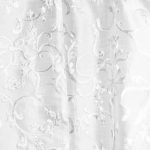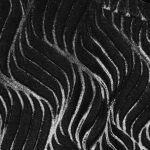You might think making a dress without sewing is impossible, but with the right fabrics, it's completely doable.
Discover five versatile fabrics that lend themselves perfectly to creating a no-sew dress. From the stretchy comfort of jersey fabric to the ethereal beauty of tulle, each fabric offers unique possibilities for crafting a stunning garment without ever touching a needle and thread.
Whether you're a beginner or a seasoned DIY enthusiast, mastering the art of creating a no-sew dress opens up a world of creative potential.
Let's explore the exciting options and unleash your inner designer without the need for sewing skills.
Key Takeaways
- Jersey and tulle fabric are versatile and stretchy materials that allow for easy manipulation and draping, making them ideal for comfortable and stylish designs.
- Denim fabric is a sturdy and timeless option that can be styled in various ways, adding effortless cool to any outfit.
- Chiffon fabric is lightweight and airy, perfect for creating ethereal and romantic dress designs with loose silhouettes.
- Crepe fabric is versatile and has a beautiful drape, and can be styled with accessories like belts or statement necklaces for added flair.
Jersey Fabric
You can create a no-sew dress using jersey fabric, a versatile and stretchy material that's perfect for comfortable and stylish designs.
Jersey fabric is known for being stretchy and comfortable, making it an excellent choice for creating a wide range of clothing items, including dresses. Its stretchiness allows for easy manipulation and draping, making it an ideal fabric for creating flowing and form-fitting designs without the need for sewing.
Additionally, jersey fabric is versatile and easy to care for, making it a practical option for those looking to make a no-sew dress. It's available in a variety of colors and prints, giving you the freedom to explore different design possibilities. Whether you want a casual everyday dress or a more elegant evening gown, jersey fabric can accommodate your style preferences.
Its soft texture and breathability also contribute to its appeal, ensuring that your no-sew dress not only looks great but also feels comfortable to wear. With jersey fabric, you can effortlessly create a no-sew dress that meets both your style and comfort needs.
Tulle Fabric
Tulle fabric offers a lightweight and airy option for creating a no-sew dress, making it a popular choice for crafting elegant and whimsical designs. When working with tulle, consider the following:
- Tulle Dress Styles: Experiment with different silhouettes such as A-line, ball gown, or tea-length styles to showcase the ethereal nature of tulle. Layering tulle in varying lengths can create a dynamic and romantic effect, perfect for a formal evening gown or a playful cocktail dress.
- Tulle Dress Accessories: Accessorize your tulle dress with delicate embellishments like lace appliques, floral accents, or beaded details to add depth and texture. Consider adding a satin ribbon belt to cinch the waist for a polished look, or opt for a statement sash to inject personality into the ensemble.
- Tulle Color Combinations: Explore different color combinations to enhance the visual impact of your tulle dress. Whether you prefer monochromatic elegance or bold contrasts, the versatility of tulle allows for endless possibilities in creating a show-stopping no-sew dress.
Mastering the art of working with tulle can elevate your no-sew dressmaking skills, allowing you to craft stunning and effortless designs for various occasions.
Denim Fabric
When working with denim fabric for a no-sew dress, consider the sturdy structure and versatility it offers for creating casual and edgy designs.
Denim is a timeless fabric that has made a significant impact on the fashion world. Its durability and ability to hold shape make it an excellent choice for creating a no-sew denim dress.
The denim dress is a versatile piece that can be styled in various ways, making it a must-have in your wardrobe.
In recent denim fashion trends, the classic denim dress has been reimagined with modern twists, such as asymmetrical hems, off-the-shoulder designs, and statement sleeves.
The beauty of denim lies in its ability to adapt to different styles, from vintage-inspired looks to contemporary and chic ensembles. Whether you're aiming for a casual, laid-back vibe or a more polished and sophisticated appearance, the denim dress can effortlessly fit into your fashion repertoire.
With its raw, rugged appeal, the denim dress adds a touch of effortless cool to any outfit, making it a staple in fashion-forward wardrobes.
Chiffon Fabric
Chiffon fabric offers a lightweight and airy texture that can be used to create elegant and flowy dresses without the need for sewing. This delicate fabric is perfect for creating stunning dresses with minimal effort.
When working with chiffon, consider these points:
- Chiffon dress designs: Chiffon is ideal for creating ethereal and romantic dress designs. Its soft, draping quality makes it perfect for flowing maxi dresses, elegant evening gowns, and bohemian-inspired frocks.
- Easy chiffon patterns: Opt for simple dress patterns that require minimal cutting and shaping to make the most of chiffon's drape. Look for designs with loose silhouettes, such as shift dresses, wrap dresses, or A-line styles, to showcase the fabric's natural flow.
- Handling chiffon with care: Due to its delicate nature, chiffon requires gentle handling. When cutting the fabric, use sharp scissors to prevent fraying, and consider using French seams or rolled hems to finish the edges neatly without sewing.
Crepe Fabric
You can easily create a no-sew dress with crepe fabric, a versatile material that offers a beautiful drape and a range of design possibilities.
When making a no sew crepe dress, consider the weight of the fabric. Lightweight crepe works well for flowing, ethereal designs, while heavier crepe lends itself to more structured styles.
Styling tips for a crepe dress include accessorizing with a belt to cinch the waist for a more defined silhouette, or adding a statement necklace to draw attention to the neckline.
When it comes to care and maintenance, hand washing or using the delicate cycle on your washing machine is recommended for crepe fabric. To prevent wrinkles, steam the dress or use a pressing cloth when ironing. Hang the dress to air dry, and avoid wringing or twisting the fabric.
With these simple care tips, your crepe dress will maintain its elegant drape and look stunning for many wears to come.
Frequently Asked Questions
What Are Some Common Types of Garments That Can Be Made Using Jersey Fabric?
When making dress styles without sewing, jersey fabric offers versatility. You can create flowing maxi dresses or form-fitting bodycon dresses with minimal effort. Embrace no-sew techniques like knotting and draping to fashion stunning garments.
Is Tulle Fabric Suitable for Making Formal or Casual Dresses?
Tulle fabric is versatile and suitable for both formal and casual dress styles. Its lightweight and airy nature makes it perfect for formal gowns, while its ethereal quality also works well for whimsical, casual dresses.
Can Denim Fabric Be Used to Create More Structured or Tailored Dress Designs?
Yes, denim fabric can be used to create more structured or tailored dress designs. The sturdy nature of denim lends itself well to tailored styles, and with the right tailoring techniques, you can achieve a polished denim dress look.
What Are Some Tips for Working With Chiffon Fabric to Avoid Fraying and Tearing?
When working with chiffon, prevent fraying by using pinking shears or a rotary cutter with a zigzag blade. Handle delicate fabric with care, and consider using a stabilizer or stay tape to reinforce seams.
Are There Any Specific Design Considerations When Using Crepe Fabric for a No-Sewing Dress?
When using crepe fabric for a no-sewing dress, consider its drape and texture for the design. Utilize techniques like folding and knotting to create structure. Experiment with layering and asymmetrical cuts to enhance the fabric's fluidity.
- How Does Ring Spun Cotton Affect Garment Fit and Shape Retention? - August 13, 2024
- What Are the Challenges in Producing Ring Spun Cotton? - August 13, 2024
- Is Ring Spun Cotton Suitable for Plus-Size Clothing? - August 13, 2024






